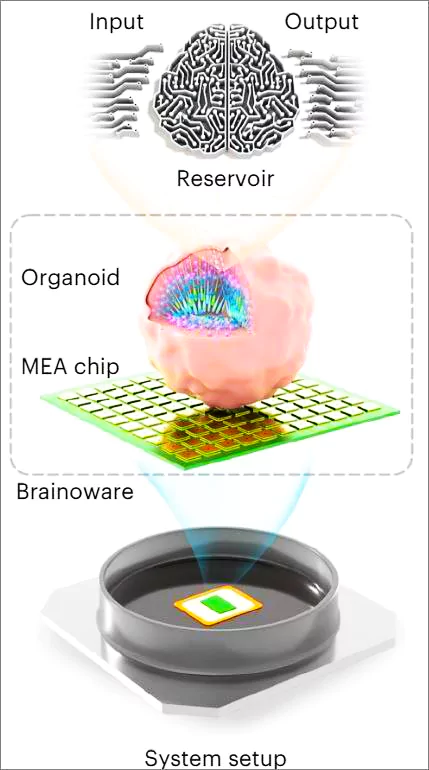Context:
Scientists have combined real human brain tissue with electronics to make a new kind of biocomputer.
- It will Extend the scope of neuromorphic computing to make an ‘organoid neural network’ that can recognise voices and solve complex mathematical problems.
Neuromorphic computing :
- It is a process in which computers are designed and engineered to mirror the structure and function of the human brain.
|
What Are Brain Organoids?
- An organoid refers to three-dimensional structures typically originating from stem cells.
- These structures have the ability to simulate both the architecture and functionality of specific organs within the body.
Stem cells:
- Stem cells are special human cells that are able to develop into many different cell types. This can range from muscle cells to brain cells.
|
- Brain organoids : These are three-dimensional aggregates of brain cells.
- They are formed by extracting human pluripotent stem cells,( which are cells that can develop to become almost any kind of cell within the human body, and make them into brain cells).
- Brain organoids are aggregates of neuron progenitor cells, early-stage neurons, mature neurons, and astrocytes (cells that maintain and protect neurons).
What Are Organoid Neural Networks ?
These are networks formed by changing the function of self-organizing brain-like structures called organoids which are connected to microelectrode arrays (MEAs) to create networks that resemble real brains.

How Will Brainoware Work?
It linked a brain organoid to microelectrodes, forming an organoid neural network, a live component in an artificial neural network.
- This network was integrated into a reservoir computer, consisting of three layers: input, reservoir, and output.
- Input signals(electrical stimulation) were processed by the reservoir( organoid neural network), a black-box system converting signals into mathematical entities. The output layer, modified computer hardware, recognized Brainoware’s neural activity.
Scientific Demonstration of Brainoware’s Skills
- Accurately predicting a Henon map, a math function generating chaotic or non-chaotic graphs based on two variables.
- It also identified Japanese vowels voiced by individuals, achieving 78% accuracy after learning from 240 audio clips in just two days.
Potential Applications of Brainoware
- To learn faster and be more energy-efficient than traditional silicon-based machines.
- By decreasing the time and energy demands as unlike AI hardware, brain cells store memory and process data without physically separating the two.
- To address current limitations in Artificial intelligence applications.
- To enable advances in fields such as medical science and treatment.
- It will yield fundamental insights into learning mechanisms,neural development and cognitive implication of neuro degenerative diseases.
- It could also add in developing preclinical models of cognitive impairment for testing new therapeutics.
Challenges with Brainoware
- Technological : Requires technical expertise and infrastructure to maintain a biological neural network because of heterogeneous mix of cell types.
- Ethical Concern : Whether it would be fair to “use organoids in a mechanistic way without being aware of their state of consciousness”.
Conclusion
The research represents a groundbreaking and captivating proof-of-concept exploration into organoid intelligence, demonstrating the potential utilization of brain organoids for adaptive reservoir computing.
Also Read: Elon Musk’s Neuralink Implants Brain Chip In First Human
News Source: The Hindu
![]() 1 Feb 2024
1 Feb 2024
